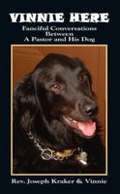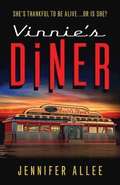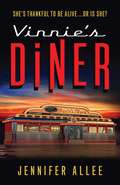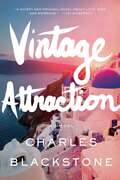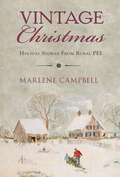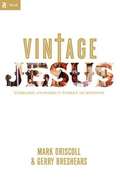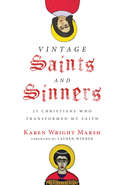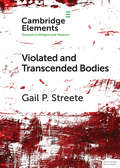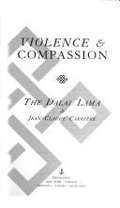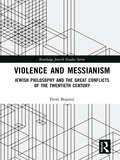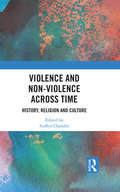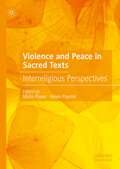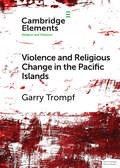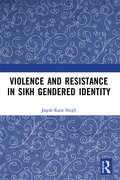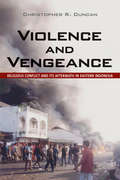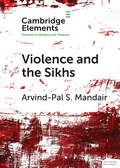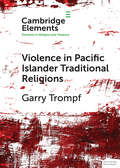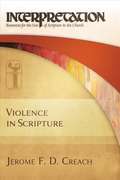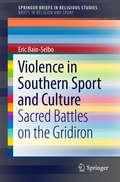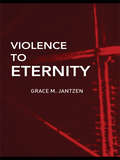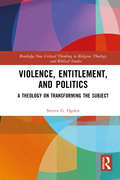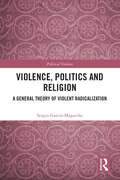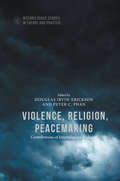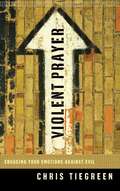- Table View
- List View
Vinnie Here: Fanciful Conversations Between A Pastor And His Dog
by Joseph Kraker VinnieA collection of meditations in three parts. First is a brief statement of each topic from celebrating holidays, to resisting consumerism, to helping the poor, to getting along, to adapting to change, to facing adversity. Second a conversation about the theme between the pastor and his dog, who sometimes teaches, and sometimes learns while seeing the world through a dog's innocent eyes, concerned with food, toys, walks, coping with people and other animals, and balancing his instincts to please himself and his beloved master. These capture the pastor's and dog's personalities and are based on Vinnie's actual experiences from walking in subzero weather to being hit by a car to being unfriendly to a donkey. They are clear, often humorous and always uplifting little parables. Third are three brief suggestions for personal reflection to encourage readers to think more deeply about each topic and find its personal relevance. About this book the author says: "Anybody who has a dog and therefore talks to his or her dog will appreciate the spirit in which these stories are written. Like me, you not only talk to your dog, but you also provide the dog's answers, and thus comes the dialogue. The one addition I have made in compiling these stories is the introductions, which show that I actually had a thought in mind each time I sat down to write. The discussion questions at the end of each story may prove helpful. If not, disregard them." Pictures are described.
Vinnie's Diner
by Jennifer AlleeWhen a freak accident leaves Allie stranded in the middle of the desert, she's thankful to still be alive. Or is she? She's rescued from the wreck by Vinnie, owner of a roadside establishment filled with people who shouldn't be there. Or is it Allie who doesn't belong? Standing at the window, she recalls important events from her past and watches as EMTs pull her own body from her mangled vehicle. Suddenly, it becomes clear this is no ordinary pit stop. In Vinnie's Diner, Allie embarks on a harrowing journey of self-discovery, literally facing her demons and making the ultimate decision...between life and death.
Vinnie's Diner
by Jennifer AlleeSomething big and black crashes against the windshield, and an explosion rocks the car. Turn into the skid! I see a flash and something in front of me. Something tall with black material flapping around it like the tail ends of an old-fashioned duster. Long, straw-colored hair. A scraggily goatee. A man? What's a man doing at the side of the road in the middle of nowhere? Why's he just standing there? Why doesn't he get out of the way? I yank the wheel back the other way, and the car swerves around him. And heads straight off the road. When the world stops bouncing and the car settles, I try to keep my eyes focused, but everything blurs around the edges. The waves ebb, and I hear a crunching sound, like boots on gravel. Straining to see, I barely make out . . . What is that? A flag? No, it's that flapping black material. I think it's the man I swerved to miss. A sweet, melodious voice makes its way through the undulating roar in my ears. "Let me help you." Help. Yes, I need help.
Vintage Attraction
by Charles BlackstoneBefore Peter Hapworth meets Izzy, he knows the difference between Pinot Noir and peanut butter, but that's about it. Lonely and frustrated with his academic career--as well as with dating--his life takes a sudden turn one night when he turns on the television. He's transfixed by the woman staring back at him, a glass of wine swirling delicately in her hand--Isabelle Conway, one of the preeminent sommeliers in the world. There's something about her. Somehow, he feels like he already knows her. On a whim, he pitches himself as a guest on her popular TV show, and the two embark on a whirlwind courtship. But relationships require a delicate balance of nurturing and belief, much like winemaking. Hapworth and Izzy must navigate the complex mysteries of wine--and the heart--from glamorous social events and domestic tribulations in Chicago to the vineyards and rocky bluffs of Santorini in Greece. Vintage Attraction is a rich and insightful novel by an exciting literary talent.
Vintage Christmas: Holiday Stories from Rural PEI
by Marlene CampbellThis delightful collection of eighteen true Christmas stories transports readers to Prince Edward Island and rustic, heartwarming holidays of the past. Travel back in time to when Christmas was a simple affair: children were content to receive an apple, an orange, or a piece of barley candy in their stockings; clothes, meals, and decorations were all homemade; and it was time spent with family—not expensive gifts—that warmed hearts during the holiday season. In this nostalgic story collection, author and local historian Marlene Campbell collects eighteen stories of Christmas celebrations from the 1930s, &‘40s, &‘50s, and &‘60s. Discover the simple joys of the unheated farmhouses, thrilling &“big-city&” department stores, and cozy barn stalls of rural Prince Edward Island. It turns out one thing has not changed: the most memorable part of any Christmas cannot be bought and sold.
Vintage Jesus: Timeless Answers to Timely Questions
by Mark Driscoll Gerry BreshearsSome two thousand years after he walked the earth, Jesus Christ is still a hot topic. And for all the ridiculous, twisted, Da Vinci Code-esque conspiracy theories and lies about Jesus that have permeated popular culture and even the academy over the years, the truth about his character, nature, and work has not changed. So what exactly is the truth about Jesus Christ? That's the question the authors of Vintage Jesus seek to answer by breaking it down into a number of sub-questions about Jesus, including Is Jesus the only God? Why did Jesus come to earth? Did Jesus rise from death? Why should we worship Jesus? and others. Nonbelievers and new Christians looking to sit down and delve into the topic of Jesus, asking the toughest, most confounding questions they can think of, will find solid, biblical answers presented in a relevant, accessible way. "In a society where the Nicene Creed doesn't hold as much water as a tall Americano, Mark Driscoll and Gerry Breshears take an unabashed stance on biblical theology that comes as a refreshing yet timeless hyssop in response to a Christian sociological breakdown of truth." Brandon Ebel, President, Tooth & Nail Records. "Mark Driscoll and Gerry Breshears combine profound understanding of modern culture with weighty Christian doctrine that is faithful to the Bible. It's written in such an interesting style that it's hard to put down. I strongly recommend it!" Wayne Grudem, Research Professor of Bible and Theology, Phoenix Seminary, Phoenix, Arizona. "A great book about Jesus--yesterday, today, and forever relevant. The answers provided are right on and meaningful to everyone." Allen R. Weiss, President, Worldwide Operations, Walt Disney Parks and Resorts. "This book reveals Mark Driscoll as a highly powerful, colorful, down-to-earth catechist, targeting teens and twenty-somethings with the old, old story told in modern street-cred style. And Professor Breshears ballasts a sometimes lurid but consistently vivid presentation of basic truth about the Lord Jesus Christ." J. I. Packer, Board of Governors, Professor of Theology, Regent College. "Wow! This is a powerful book. It's edgy and, frankly, it made me uncomfortable at certain points but for the right reasons. We need light, not polish, over the story of Jesus, and that's exactly what this well-written and provocative work provides. It may make you squirm, but the strong biblical orientation and the crisp historic perspectives give you a context for that squirming!" Dan Wolgemuth, President, Youth for Christ/USA, Inc. "This book presents an honest view of Jesus without giving in to the pressure to soften him up. I had to grapple with the real vintage Jesus. This is a Savior worth fighting for." Matt Lindland, 2000 Olympic silver medalist in wrestling; top-ranked middleweight mixed martial arts fighter. "This new book by Driscoll, one of the most promising young pastors I've met, and his theological partner Gerry Breshears, tells the old, old story in a contemporary, exciting, in-your-face manner. Though written to appeal to today's younger seekers, nothing of classic Christian theology is omitted. Those of my generation may bridle at some aspects of the book--but it's good if we do. This book is just what's needed for us to understand how to reach the postmoderns and a great tool to help all of us connect with young seekers. This is both bold and uncompromising. I can highly recommend it." Chuck Colson, Founder, Prison Fellowship.
Vintage Saints and Sinners: 25 Christians Who Transformed My Faith
by Karen Wright Marsh15th Annual Outreach Magazine Resource of the Year - Inspirational 2017 Foreword INDIES Award Finalist Saints are people too. The word saint conjures up images of superstar Christians revered for their spectacular acts and otherworldly piety. But when we take a closer look at the lives of these spiritual heavyweights, we learn that they also experienced struggle, doubt, and heartache. In fact, we learn that in many ways they're not all that different from you and me. Narrating her own winding pilgrimage through faith, Karen Marsh reveals surprising lessons in everyday spirituality from these "saints"—folks who lived and breathed, and failed and followed God. Told with humor and vulnerability, Vintage Saints and Sinners introduces us afresh to twenty-five brothers and sisters who challenge and inspire us with their honest faith. Using the included conversation starters, you can join Karen on her journey with the likes of Augustine, Brother Lawrence, and Saint Francis, as well as Amanda Berry Smith, Søren Kierkegaard, Dorothy Day, Howard Thurman, Flannery O'Connor, and many more. Let their lives and their wisdom be an invitation to authentic life in Christ.
Violated and Transcended Bodies: Gender, Martyrdom, and Asceticism in Early Christianity (Elements in Religion and Violence)
by Gail P. StreeteGiven its eschatological orientation and its marginal position in the Roman Empire, emergent Christianity found embodiment, as an aspect of being in the world, problematic. Those identified and identifying as Christians developed two broad responses to that world as they embraced the idea of being in, yet not of it. The first response, martyrdom, was witness to the strength their faith gave to fragile bodies, particularly those of women, and the ability by suffering to overcome bodily limitation and attain the resurrection life. The second, asceticism, complemented and later continued martyrdom as a means of bodily transcendence and participation in the spiritual world.
Violence and Compassion
by Dalai Lama Xiv Jean-Claude CarriereFor many people throughout the world, no other figure more embodies the heart of Buddhist compassion than His Holiness the Dalai Lama. As the wisdom of Tibetan Buddhism has become better known over the past several years, the Dalai Lama has become more and more of an important spiritual leader for many in the West. But while His Holiness has spoken extensively about the practice of Tibetan Buddhism, he has never before directly addressed the general questions that confront the world in the way he does in this special series of dialogues. French film writer Jean-Claude Carrière's conversations with the Dalai Lama cover the various issues and problems that challenge world civilization today--including women's rights, education, terrorism, the population explosion, environmental dangers, and an increase in both random and organized violence. The Dalai Lama exhibits his characteristic warmth and clarity of thought throughout each of these discussions, but what is most valuable is his ability to cut through to the essence of each issue and offer insightful guidance. From these precious talks come profound wisdom and pragmatic challenges for humanity's move into the next millennium.
Violence and Messianism: Jewish Philosophy and the Great Conflicts of the Twentieth Century (Routledge Jewish Studies Series)
by Petar BojanićViolence and Messianism looks at how some of the figures of the so-called Renaissance of "Jewish" philosophy between the two world wars - Franz Rosenzweig, Walter Benjamin and Martin Buber - grappled with problems of violence, revolution and war. At once inheriting and breaking with the great historical figures of political philosophy such as Kant and Hegel, they also exerted considerable influence on the next generation of European philosophers, like Lévinas, Derrida and others. This book aims to think through the great conflicts in the past century in the context of the theory of catastrophe and the beginning of new messianic time. Firstly, it is a book about means and ends – that is, about whether good ends can be achieved through bad means. Second, it is a book about time: peace time, war time, time it takes to transfer from war to peace, etc. Is a period of peace simply a time that excludes all violence? How long does it take to establish peace (to remove all violence)? Building on this, it then discusses whether there is anything that can be called messianic acting. Can we – are we capable of, or allowed to – act violently in order to hasten the arrival of the Messiah and peace? And would we then be in messianic time? Finally, how does this notion of messianism – a name for a sudden and unpredictable event – fit in, for example, with our contemporary understanding of terrorist violence? The book attempts to understand such pressing questions by reconstructing the notions of violence and messianism as they were elaborated by 20th century Jewish political thought. Providing an important contribution to the discussion on terrorism and the relationship between religion and violence, this book will appeal to theorists of terrorism and ethics of war, as well as students and scholars of Philosophy, Jewish studies and religion studies.
Violence and Non-Violence across Time: History, Religion and Culture
by Sudhir ChandraThis book probes the complex interweaving, across time and cultures, of violence and non-violence from the perspective of the present. One of the first of its kind, it offers a comprehensive examination of the interpenetration of violence and non-violence as much in human nature as in human institutions with reference to different continents, cultures and religions over centuries. It points to the present paradox that even as violence of unprecedented lethality threatens the very survival of humankind, non-violence increasingly appears as an unlikely feasible alternative. The essays presented here cover a wide cultural–temporal spectrum — from Vedic sacrifice, early Jewish–Christian polemics, the Crusades, and medieval Japan to contemporary times. They explore aspects of the violence–non-violence dialectic in a coherent frame of analysis across themes such as war, jihad, death, salvation, religious and philosophical traditions including Buddhism, Christianity, Judaism, Hinduism, Islam, mysticism, monism, and Neoplatonism, texts such as Ramayana, Mahabharata and Quran, as well as issues faced by Dalits and ethical imperatives for clinical trials, among others. Offering thematic width and analytical depth to the treatment of the subject, the contributors bring their disciplinary expertise and cultural insights, ranging from the historical to sociological, theological, philosophical and metaphysical, as well as their sensitive erudition to deepening an understanding of a grave issue. The book will be useful to scholars and researchers of history, peace and conflict studies, political science, political thought and cultural studies, as well as those working on issues of violence and non-violence.
Violence and Peace in Sacred Texts: Interreligious Perspectives
by Helen Paynter Maria PowerThis volume brings together 11 experts from a range of religious backgrounds, to consider how each tradition has interpreted matters of violence and peace in relation to its sacred text. The traditions covered are Hinduism, Buddhism, Judaism, Christianity, Islam and Sikhism. The role of religion in conflict, war, and the creation of peaceful settlements has attracted much academic attention, including considerations of the interpretation of violence in sacred texts. This collection breaks new ground by bringing multiple faiths into conversation with one another with specific regard to the handling of violence and peace in sacred texts. This combination of close attention to text and expansive scope of religious inclusion is the first of its kind.
Violence and Religious Change in the Pacific Islands (Elements in Religion and Violence)
by Garry TrompfThis Element considers patterns of violent behaviour among the inhabitants of the Pacific Islands while their vast region has been undergoing religious change, overwhelmingly toward Christianity. Major topics researched are religion-based violent reactions to early intruders (including missionaries); new religious movements resisting unwanted interference (including 'cargo cults'); anti-colonial rebellions inspired by spiritual impetuses both indigenous and introduced; and the persistence of traditional modes of violence (tribal fighting, sorcery and tough punishments) adapted to altered conditions.
Violence and Resistance in Sikh Gendered Identity
by Jaspal Kaur SinghThis book examines the constructions and representations of male and female Sikhs in Indian and diasporic literature and culture through the consideration of the role of violence as constitutive of Sikh identity. How do Sikh men and women construct empowering identities within the Indian nation-state and in the diaspora? The book explores Indian literature and culture to understand the role of violence and the feminization of baptized and turbaned Sikh men, as well as identity formation of Sikh women who are either virtually erased from narratives, bodily eliminated through honor killings, or constructed and represented as invisible. It looks at the role of violence during critical junctures in Sikh history, including the Mughal rule, the British colonial period, the Partition of India, the 1984 anti-Sikh riots in India, and the terror of 9/11 in the United States. The author analyzes how violence reconstitutes gender roles and sexuality within various cultural and national spaces in India and the diaspora. She also highlights questions related to women’s agency and their negotiation of traumatic memories for empowering identities. The book will interest scholars, researchers, and students of postcolonial English literature, contemporary Indian literature, Sikh studies, diaspora studies, global studies, gender and sexuality studies, religious studies, history, sociology, media and films studies, cultural studies, popular culture, and South Asian studies.
Violence and Vengeance
by Christopher R. DuncanBetween 1999 and 2000, sectarian fighting fanned across the eastern Indonesian province of North Maluku, leaving thousands dead and hundreds of thousands displaced. What began as local conflicts between migrants and indigenous people over administrative boundaries spiraled into a religious war pitting Muslims against Christians and continues to influence communal relationships more than a decade after the fighting stopped. Christopher R. Duncan spent several years conducting fieldwork in North Maluku, and in Violence and Vengeance, he examines how the individuals actually taking part in the fighting understood and experienced the conflict. Rather than dismiss religion as a facade for the political and economic motivations of the regional elite, Duncan explores how and why participants came to perceive the conflict as one of religious difference. He examines how these perceptions of religious violence altered the conflict, leading to large-scale massacres in houses of worship, forced conversions of entire communities, and other acts of violence that stressed religious identities. Duncan's analysis extends beyond the period of violent conflict and explores how local understandings of the violence have complicated the return of forced migrants, efforts at conflict resolution and reconciliation.
Violence and the Sikhs (Elements in Religion and Violence)
by Arvind-Pal S. MandairViolence and the Sikhs interrogates conventional typologies of violence and non-violence in Sikhism by rethinking the dominant narrative of Sikhism as a deviation from the ostensibly original pacifist-religious intentions and practices of its founders. This Element highlights competing logics of violence drawn from primary sources of Sikh literature, thereby complicating our understanding of the relationship between spirituality and violence, connecting it to issues of sovereignty and the relationship between Sikhism and the State during the five centuries of its history. By cultivating a non-oppositional understanding of violence and spirituality, this Element provides an innovative method for interpreting events of 'religious violence'. In doing so it provides a novel perspective on familiar themes such as martyrdom, Martial Race theory, warfare and (post)colonial conflicts in the Sikh context.
Violence in Pacific Islander Traditional Religions (Elements in Religion and Violence)
by Garry TrompfAn Element on the role of violence in the traditional religions of the Pacific Ilands (Melanesia, Micronesia and Polynesia) and on violent activity in islander religious life after the opening of Oceania to the modern world. This work covers such issues as tribal warfare, sorcery and witchcraft, traditional punishment and gender imbalance. and moves on to consider reprisals against foreign intruders in the Pacific and the continuation of old types of violence in spite of massive socio-religious change.
Violence in Scripture
by Jerome F. D. CreachThe Bible frequently depicts God as angry and violent, and also sometimes depicts human violence as positive or even as commanded by God. This forms one of the most vexing problems in approaching Scripture and in interpreting the Bible for preaching and teaching today. In this volume, Creach first examines the theological problems of violence and categorizes the types of violence that appear in scripture. Then, he wrestles with the most important biblical texts on violence to work through specific interpretational issues. This new volume in the Interpretation: Resources for Use of Scripture in the Church series will help preachers and pastors interpret those difficult texts, encouraging them to face violence in the Bible with honesty.
Violence in Southern Sport and Culture
by Eric Bain-SelboThis book discusses violence and its connection with religion, sport and popular culture. It highlights the religious dimensions of violence and the role of violence in the religion and culture of the American South. Extending into popular culture, it then makes the case that sport--particularly American football--is a cultural phenomenon in the South with close ties with religion and violence, and that American football has come to play a central role in the civil religion of the South, fueled in part by its violent nature. The book concludes by drawing important lessons from this case study--lessons that help us to see both religion and sport in a new light.
Violence in Southern Sport and Culture: Sacred Battles on the Gridiron (SpringerBriefs in Religious Studies)
by Eric Bain-SelboThis book discusses violence and its connection with religion, sport and popular culture. It highlights the religious dimensions of violence and the role of violence in the religion and culture of the American South. Extending into popular culture, it then makes the case that sport—particularly American football—is a cultural phenomenon in the South with close ties with religion and violence, and that American football has come to play a central role in the civil religion of the South, fueled in part by its violent nature. The book concludes by drawing important lessons from this case study—lessons that help us to see both religion and sport in a new light.
Violence to Eternity (Death and the Displacement of Beauty)
by Grace M. JantzenIn this volume Grace M. Jantzen continues her groundbreaking analysis of death and beauty in western thought by examining the religious roots of death and violence in the Jewish and Christian tradition, which underlie contemporary values. She shows how man’s fear of the female is often implicated in religious violence and in her critique of the Hebrew Bible and the Christian New Testament she examines a range of themes that show the western preoccupation with necrophilia. She examines the relation of death to the Jewish covenant, the nature of monotheism, Holy War and the Christian covenant and kingdom. However, Jantzen recognises that submerged beneath these themes in Judaism and Christianity are traces of an alternative world of beauty and life. Jantzen’s internationally recognised feminist philosophy of religion puts forward a powerful analysis of patriarchy and violence and reveals the hidden power of natality. Her work is a searching challenge for our times and one that gives hope in a violent world. This work is the first of two posthumous publications to complete her impressive genealogy death and beauty of western thought.
Violence, Entitlement, and Politics: A Theology on Transforming the Subject (Routledge New Critical Thinking in Religion, Theology and Biblical Studies)
by Steven G. OgdenThis book is an exercise in political theology, exploring the problem of gender-based violence by focusing on violent male subjects and the issue of entitlement. It addresses gender-based violence in familial and military settings before engaging with a wider political context. The chapters draw on sources ranging from Michel Foucault, Judith Butler, and Étienne Balibar to Rowan Williams and Elisabeth Schüssler Fiorenza. Entitlement is theorized and interpreted as a gender pattern, predisposing subjects toward controlling behaviour and/or violent actions. Steven Ogden develops a theology of transformation, stressing immanence. He examines entitled subjects, predisposed to violence, where transformation requires a limit-experience that wrenches the subject from itself. The book also reflects on today’s pervasive strongman politics, where political rationalities foster proprietorial thinking and entitlement gender patterns, and how theology is called to develop counter-discourses and counter-practices.
Violence, Politics and Religion: A General Theory of Violent Radicalization (ISSN)
by Sergio García-MagariñoThis book offers a general theory of violent radicalization and uses case studies from a variety of different countries and groups to illustrate this.The first and fundamental objective of the book is to provide an explanatory framework to understand phenomena related to violent radicalization, deradicalization, the prevention of radicalization and to political violence; in particular, that inspired by religion. The second objective follows from the first. Understanding violent radicalization of religious inspiration implies delving into two key concepts: violent radicalization and religion. This second objective is indeed elusive, since, on the one hand, many liberal democracies have undergone processes of secularization or, at least, have lost interest in examining religion in public debates. Therefore, rigorously exploring social problems where religion seems to be involved, in one way or another, is complicated. Moreover, the notion of violent radicalization, in turn, is highly contested and confused with other ideas, such as polarization, extremism, terrorism or nonviolent radicalization. Finally, the book aims to bring theory into dialogue with empirical phenomena, and to test it against concrete cases related to violent radicalization and its prevention, on the one hand, and religion, on the other. The book’s originality comes from both its innovative, methodological approach and its breadth, with cases from several countries (Spain, the United States, Ireland, India, Israel, Russia and Colombia) and different ideological groups (revolutionary communists, nationalist movements, Jihadist groups, white and black supremacists).This book will be of much interest to students of terrorism and political violence, radicalization, sociology and international relations in general.
Violence, Religion, Peacemaking
by Peter C. Phan Douglas Irvin-EricksonThis volume explores how religious leaders can contribute to cultures of peace around the world. The essays are written by leading and emerging scholars and practitioners who have lived, taught, or worked in the areas of conflict about which they write. Connecting the theory and practice of religious peacebuilding to illuminate key challenges facing interreligious dialogue and interreligious peace work, the volume is explicitly interreligious, intercultural, and global in perspective. The chapters approach religion and peace from the vantage point of security studies, sociology, ethics, ecology, theology, and philosophy. A foreword by David Smock, the Vice President of Governance, Law and Society and Director of the Religion and Peacebuilding Center at the United States Institute of Peace, outlines the current state of the field.
Violent Prayer: Engaging Your Emotions Against Evil
by Chris TiegreenPray from Your Gut Satan is alive, well, and actively searching for opportunities to ruin you. Perhaps your trying circumstances or struggling relationships reflect his schemes. Does that make you angry? If you’ve ever suppressed simmering anger toward the enemy, seeing it as an intrusion into your prayers, it’s time you experience the power of violent prayer. These very emotions of hatred and anger against Satan are fuel for life-changing prayer. Overcome an unhealthy, passive approach to prayer that dilutes your communion with the reigning Victor. When you move from defensive, reactive prayers to offensive, proactive prayers with an aggressive agenda, things begin to change. And you don’t want to miss out. When the Battle Rages, Wage Prayer You witness evil all around and it bothers you. You fall to your knees and tentatively, hopefully, you approach God and ask Him to step in. But nothing happens. Goodness and righteousness seem to be fighting a losing battle. You wonder,Why is God so passive? Perhaps the better question is this: Why areyouso passive when it comes to prayer? Embrace the infuriating, passionate emotion that wells up within you against Satan and his schemes. Turn your righteous anger into proactive, aggressive prayers that invite God to intervene and destroy the evil around you. Engage inviolent prayer. “Chris Tiegreen writes with wisdom, knowledge, and creativity. Violent Prayeris a wonderful resource for Christians who want to make prayer a more powerful part of their lives. ” Carol Pipes Editor,On Mission Story Behind the Book “Especially in praying for my family, I’ve learned that there is a connection between the emotional content of my prayers and the results I see later. Many such experiences have convinced me that ‘violent’ prayers can be quite appropriate and effective. My book gets into the nuts and bolts of praying God’s agenda without reducing it to formulas, hierarchies, military strategies, or any other clichéd approach to spiritual warfare. It primarily addresses the emotional attitude of the believer and describes how to incorporate God’s holy anger into prayer for specific situations. Christians will learn how to pray from their gut-level reactions to the enemy’s agenda. ” -Chris Tiegreen From the Trade Paperback edition.
